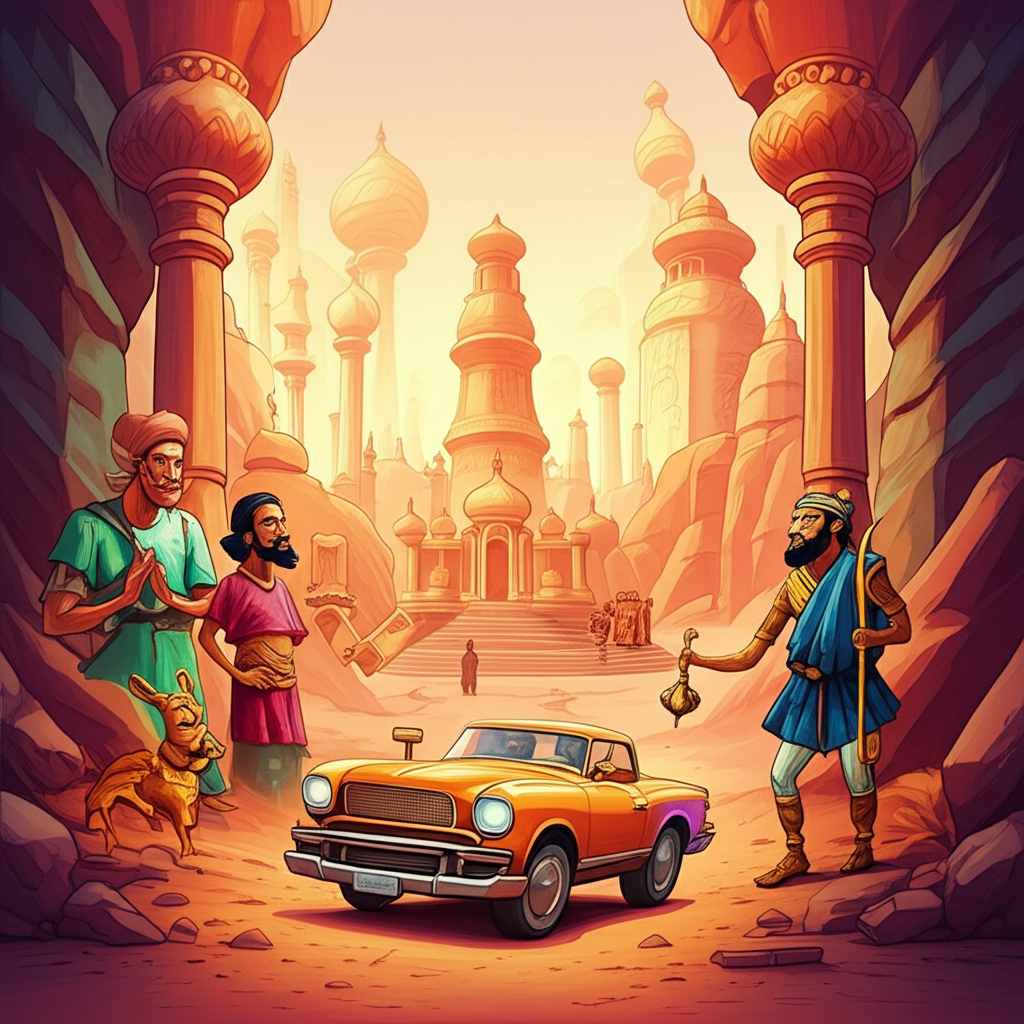
In the sun-scorched heart of the Middle East, where ancient winds sculpt the very landscape into tales of ages past, a legend whispers through the canyons and echoes from the rose-red cliffs. This is not a story of verifiable history, but a vibrant thread woven into the rich tapestry of folklore, a traditional narrative passed down through generations by the peoples who once traversed these arid lands. It is the myth of the City of Brass, a fantastical origin story for the breathtaking city of Petra, a place that even today inspires awe with its monumental rock-cut architecture. This tale, born from the collective imagination of ancient peoples, speaks to their understanding of the world, their fears, and their wonder at the enduring mysteries of their homeland.
The era in which such myths likely took root was one where the boundaries between the seen and the unseen were far more fluid. In the ancient Arabian Peninsula, life was a constant negotiation with a powerful and often unforgiving environment. The vast deserts, with their sudden sandstorms and hidden oases, were imbued with a palpable sense of the divine and the supernatural. The sun, a blazing, life-giving, and sometimes destructive force, was a central figure in their worldview. They saw the natural world not as a collection of inert objects, but as a dynamic realm populated by spirits, jinn, and beings with motivations and powers beyond human comprehension. Their stories served as a way to explain the unexplainable, to impart moral lessons, and to grapple with the awe-inspiring beauty and terrifying power of their surroundings. The City of Brass, therefore, emerges from a cultural milieu where the extraordinary was an accepted, even expected, part of existence.
Central to this legend is the idea of a magnificent, hidden city, often described as being constructed not of stone, but of gleaming brass. This City of Brass was said to be a place of immense wealth and power, often guarded by fearsome creatures or enchanted defenses. The very material, brass, carries symbolic weight. It is a metal that shines brightly, reflecting the sun’s fierce rays, and it is durable, suggesting a lasting, perhaps even eternal, quality. In some interpretations, the brass could represent earthly riches and material splendor, a testament to human ambition and ingenuity. However, it also carries an association with fire and heat, mirroring the relentless desert sun and the potential dangers that lay hidden beneath its alluring surface. The city itself, as a concept, often embodied the ultimate prize, a place of untold wonders, but also a place fraught with peril, a testament to the dual nature of desire and discovery.
The narrative of the City of Brass, as it pertains to Petra, often begins with tales of its mythical builders. These were not ordinary mortals, but beings of immense power, perhaps jinn, or a race of ancient kings and sorcerers. They are said to have possessed the knowledge to manipulate the very earth, carving out this city from solid rock with supernatural skill. One common thread in these stories involves a powerful king, often named Sulayman (Solomon in Jewish and Christian traditions, but here presented within the context of Arabian folklore), who, through his wisdom and divine favor, was able to command the jinn to construct the city. The jinn, compelled by his authority, would have toiled for years, forging the gleaming brass and shaping the colossal structures that would become the City of Brass.
The stories often describe a grand expedition to find this fabled city. Brave, or perhaps foolhardy, adventurers would embark on perilous journeys into the desolate desert, guided by ancient maps or whispered rumors. They would face trials and tribulations, battling sandstorms, treacherous terrain, and perhaps even mythical beasts that guarded the path. Upon finally reaching their destination, they would behold a sight beyond their wildest dreams: a city of impossible beauty, its walls and buildings forged from radiant brass, shimmering under the desert sun. However, their triumph would often be short-lived. The city, it was said, was not meant to be conquered or inhabited by mortals. It was either a trap, designed to ensnare the unwary, or a place protected by powerful enchantments that would turn intruders into stone or lead them to their doom. The narrative would then often culminate in the city’s disappearance, swallowed by the sands or sealed away by its magical guardians, leaving behind only whispers and legends.
The symbolism embedded within the City of Brass myth is multifaceted. The grand, hidden city could represent the unattainable ideal, the ultimate human desire for a perfect, prosperous realm. The brass itself might symbolize earthly power and wealth, the allure of which could blind individuals to its potential dangers. The jinn, as mythical beings, often represent the forces of nature, the wild and untamed aspects of the world, and the inherent power that lies beyond human control. The story could also be interpreted as a cautionary tale about hubris and the dangers of seeking forbidden knowledge or excessive wealth. The disappearance of the city serves as a potent reminder of the ephemeral nature of material possessions and the ultimate power of the natural world or the divine to reclaim what has been created. It reflects a worldview that acknowledged the existence of forces greater than humanity, forces that dictated the rise and fall of empires and the fate of even the grandest human endeavors.
In contemporary times, the concept of the City of Brass has transcended its folkloric origins to become a potent motif in various forms of media. It appears in fantasy literature, inspiring tales of lost cities and hidden treasures. In video games, it is often depicted as a challenging dungeon or a legendary treasure trove, its brass architecture a visual spectacle. Films and television shows have also drawn inspiration from its mystique, using it as a setting for adventure and intrigue. Beyond entertainment, the myth remains a subject of study for cultural anthropologists and historians, offering insights into the belief systems, values, and storytelling traditions of ancient Arab societies. It serves as a window into how people perceived their environment and their place within it, a testament to the enduring power of human imagination.
In conclusion, the myth of the City of Brass, as a purported origin for Petra, is a fascinating artifact of cultural heritage. It is a traditional story, a product of ancient imaginations grappling with a vast and awe-inspiring world. It is crucial to understand that these are narratives, not accounts of factual events or divine pronouncements. As Muslims, we recognize that only Allah is the true Creator and Sustainer of all that exists. These ancient tales, however, offer valuable insights into the cultural landscape from which they emerged, revealing the beliefs, fears, and aspirations of past peoples. They remind us of the rich tradition of storytelling that has shaped human understanding and continue to fuel our collective imagination, a testament to the enduring power of myth and legend to captivate and inform us across the ages.





